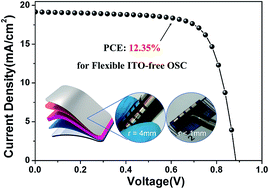Interface bonding engineering of a transparent conductive electrode towards highly efficient and mechanically flexible ITO-free organic solar cells†
Abstract
Organic solar cells (OSCs) have significant potential applications in flexible and wearable electronics. However, commonly used indium tin oxide (ITO)-based electrodes are rigid, bulky and fragile; thus, the bending stability issues of the flexible ITO-free devices should be addressed with more attention. In this study, we introduced a poly(3,4-ethylenedioxythiophene):polystyrene sulfonate (PEDOT:PSS [herein PH1000]) flexible electrode and investigated the effect of interface bonding engineering on the performance of the flexible device by a facile solution-processed approach with doping of natural polyhydroxy compounds. Based on the PBDB-T-2Cl:IT-4F photoactive system, the highest power conversion efficiency (PCE) of 12.35% was achieved by D-maltose-doped PH1000/PET composite electrodes, with the open-circuit voltage (Voc) of 0.885 V, the short-circuit current (Jsc) of 19.13 mA cm−2, and the fill factor (FF) of 72.92%. This is one of the highest values reported to date for flexible OSCs. Most importantly, the bending performance of the flexible OSCs was significantly improved by the interface bonding engineering due to the dramatic enhancement of the adhesion capability between the PH1000 electrode and PET flexible substrate; this resulted in an excellent bending performance, and ∼92% of the original PCE value could be maintained after 1000 bending cycles (r = 4 mm) and ∼80% of that could be maintained after 1000 folding cycles (r < 1 mm). The results open a favorable avenue for the realization of highly efficient and flexible ITO-free organic solar cells.



 Please wait while we load your content...
Please wait while we load your content...